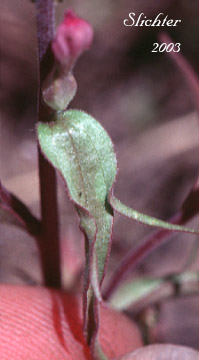 The
photo at right shows a lower bract-like leaf of Copeland's owl-clover as seen
at Jackman Park C.G........June 26, 2000.
The
photo at right shows a lower bract-like leaf of Copeland's owl-clover as seen
at Jackman Park C.G........June 26, 2000.
Copeland's owl-clover is a very attractive annual wildflower. The erect stems are usually simple, rising from 7-22 cm high. The herbage consists of purplish hairs. The stem leaves are linear-lanceolate in shape with the lower leaves with entire margins and the upper leaves three-lobed. The leaves range from 2-4 cm long.
The inflorescence is a short, dense spike. The bracts are ovate to broadly lanceolate in shape with 1-2 pairs of small, spreading lateral lobes. The bracts are greenish, the upper with purplish tips, and they closely overlap, often concealing the corollas. The calyx is 5-9 mm long with lateral clefts 1.2-2.6 mm deep, the lower cleft 2-4 mm deep, and the upper 3-6 mm deep. The corolla is 9-16 mm long with the upper lip 2.5-7.5 mm long with a straight rosy to violet tip. The lower lip is 2.8-5.5 mm long and weakly 3-saccate. The lower lip is yellow or white. The similar var. cryptanthus has shorter corollas from 9-12 mm long.
Copeland's owl-clover may be found in fairly moist to dry sagebrush and bitterbrush meadows into moist rock outcrops between the elevations of 1500-3000 meters.
Copeland's owl-clover may be found from southwestern and southeastern (the Steens Mt.) Oregon south to Glenn and Mono Counties in California and to Mineral, Washoe and Humboldt Counties in Nevada.